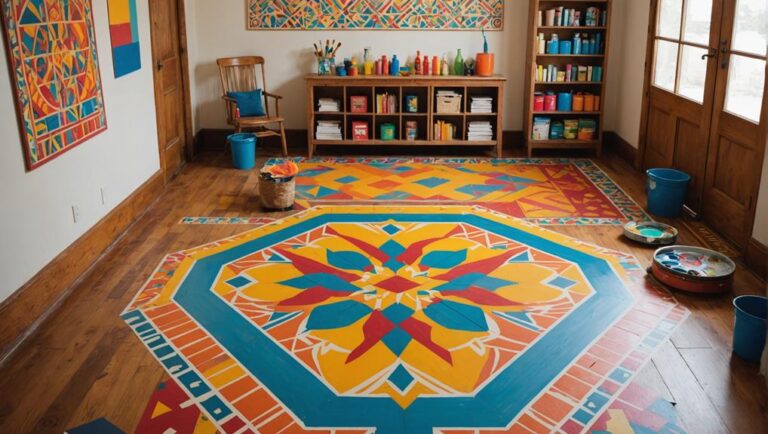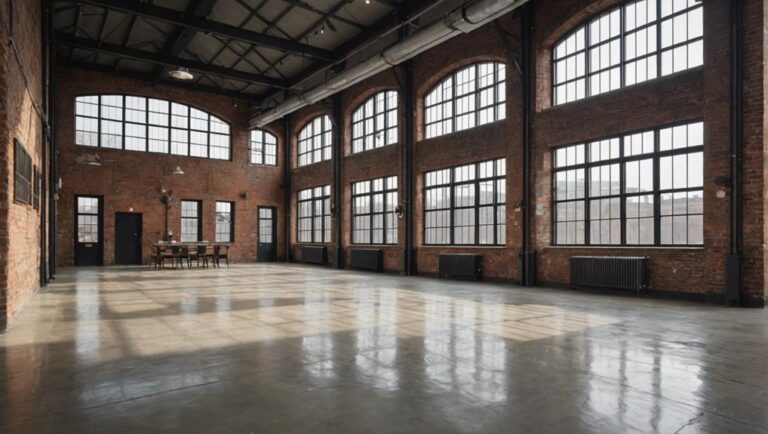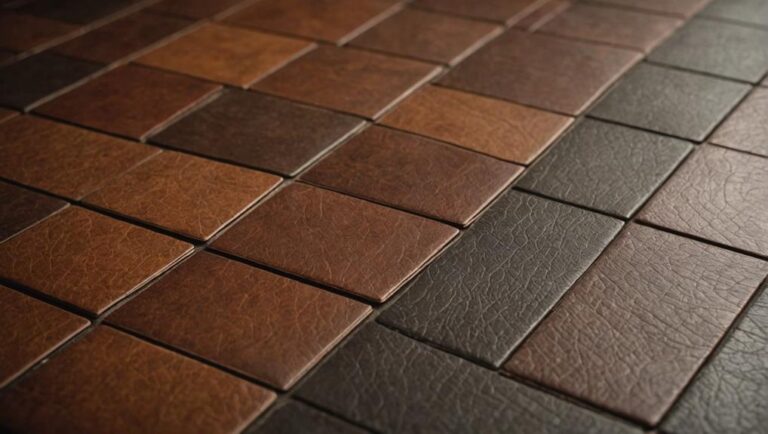To remove mildew from outdoor floors, start by identifying the affected areas, which often appear as grayish or greenish patches. Collect your cleaning supplies: a stiff-bristled brush, mild bleach or vinegar, a bucket, and water. Wear gloves and a mask for safety, then saturate the mildew with your chosen cleaner. Scrub the surface to remove the mildew, and rinse thoroughly with a hose or pressure washer. To prevent future growth, guarantee proper drainage and regularly sweep to remove debris. Curious about more tips and techniques? Stick around to discover further insights on tackling mildew effectively!
Identifying Mildew on Floors
When it comes to identifying mildew on outdoor floors, it is essential to know what to look for, especially since it can often be mistaken for dirt or grime. Mildew typically appears as a patchy, grayish-white or greenish film on surfaces, and it thrives in damp, shaded areas. To confidently distinguish it from simple dirt, you can use a couple of mildew identification techniques.
First, consider the type of outdoor floor you have. Different materials can show mildew in unique ways. For instance, wooden decks may develop soft, fuzzy patches, while concrete patios often present as a slippery surface. If you notice any discoloration or a musty odor, you might be dealing with mildew.
Next, you can perform a simple moisture test. Lightly spray a small area with water and observe how quickly it dries. If it remains damp for an extended period, that area is susceptible to mildew growth. Additionally, check for signs of water pooling or insufficient drainage, which are common culprits in mildew formation.
It's also wise to inspect regularly, especially after rain or high humidity. Remember, catching mildew early can save you a lot of trouble down the line. By employing these identification techniques and being aware of your outdoor floor types, you can take proactive steps to maintain a clean, safe environment. Knowing what mildew looks like is the first step toward effective removal and prevention.
Essential Cleaning Supplies
After identifying mildew on your outdoor floors, it's time to gather the right tools for effective cleaning. Having the proper cleaning supplies not only guarantees you'll tackle the mildew effectively but also helps you maintain safety throughout the process. Here's a handy list of essential supplies you'll need:
| Cleaning Supplies | Purpose |
|---|---|
| Broom or Brush | To sweep off loose debris |
| Bucket | To mix cleaning solutions |
| Water | To dilute cleaning solutions |
| Mild Bleach or Vinegar | Effective cleaning solutions |
| Protective Gloves | Safety precautions for your hands |
| Safety Goggles | Protect your eyes from splashes |
| Scrub Brush | To scrub the mildew off surfaces |
When choosing your cleaning solutions, opt for those that are effective yet safe for outdoor use. If you're using bleach, make sure to follow the manufacturer's instructions and wear protective gear. Vinegar is a great alternative if you want a less harsh option.
Always prioritize safety precautions—work in a well-ventilated area, and avoid mixing different cleaning solutions, as this can create harmful fumes. By gathering these essential cleaning supplies, you'll be well-prepared to tackle the mildew on your outdoor floors. Remember, the right tools are key to achieving a clean and safe environment for you and your family.
Step-by-Step Cleaning Process
Getting rid of mildew from your outdoor floors doesn't have to be an intimidating task. By following a simple step-by-step cleaning process, you can safely restore the appearance of your outdoor flooring materials. Let's break it down into manageable steps.
- Preparation: Start by gathering your cleaning supplies. Confirm you've got your chosen mildew removal techniques ready, whether it's a commercial cleaner or a DIY solution like vinegar and water.
- Safety First: Before you begin, wear protective gear like gloves and a mask. This'll keep you safe from any harmful spores or chemicals.
- Apply the Cleaner: Spray your chosen solution directly onto the affected areas. Don't forget to cover all surfaces, confirming you saturate the mildew spots well.
- Scrub Away: Use a stiff-bristled brush to scrub the area gently. Be cautious with delicate outdoor flooring materials, as too much pressure could cause damage.
- Rinse Thoroughly: After scrubbing, rinse the area with a hose or pressure washer to remove the cleaner and any loosened mildew.
- Dry Completely: Make sure the surface dries completely to prevent mildew from returning.
Preventing Future Mildew Growth
Once you've successfully cleaned your outdoor floors, it's time to think about how to keep mildew from returning. Preventing future growth involves a combination of smart maintenance and protective measures. Start by guaranteeing your outdoor area has proper drainage. Poor drainage can lead to standing water, which creates an ideal environment for mildew. If necessary, consider installing drainage solutions like trenches or grading your landscape to encourage water flow away from your floors.
Next, consider applying mildew resistant coatings to your outdoor surfaces. These specialized coatings form a protective barrier that helps repel moisture, making it harder for mildew to establish itself. Be sure to choose a product specifically designed for the material of your floors, whether it's wood, concrete, or tile, to guarantee compatibility and effectiveness.
Regular maintenance is also key. Sweep and clean your outdoor floors regularly to remove debris, leaves, and dirt, which can hold moisture and promote mildew growth. Additionally, if you live in a particularly humid area, consider using a dehumidifier in any enclosed outdoor spaces to reduce moisture levels.
When to Call a Professional
When you're faced with a stubborn mildew problem that just won't budge, it might be time to contemplate calling in a professional. Tackling mildew isn't just about aesthetics; it's also about safety. Mildew can pose health risks, particularly for those with respiratory issues or allergies. If you've tried various DIY methods with little success, consider reaching out to professional cleaning services. Here are some situations when a pro is your best option:
- Extensive Growth: If the mildew covers a large area or has penetrated deep into surfaces, professional tools and expertise are crucial.
- Health Concerns: If anyone in your household has pre-existing health conditions, it's safer to let professionals handle the cleanup to minimize exposure.
- Lack of Time or Equipment: If you don't have the necessary tools or time to tackle the job, hiring a professional can save you stress and guarantee the job is done right.
- Persistent Odor: If you notice a lingering musty smell despite your efforts, this could indicate deeper issues that require specialized treatment.
Frequently Asked Questions
Can I Use Bleach to Remove Mildew From Outdoor Floors?
Yes, you can use bleach to remove mildew, but it's important to take into account its effectiveness and safety precautions. Bleach can effectively kill mildew, but it can also harm surrounding plants and discolor surfaces. Make sure to wear gloves and a mask, and always work in a well-ventilated area. Diluting bleach with water can lessen its harshness while still maintaining effectiveness. Always test a small area first to guarantee no damage occurs.
How Often Should I Clean My Outdoor Floors to Prevent Mildew?
You might've noticed how quickly mold can creep in, turning a beautiful outdoor space into a slippery hazard. To keep mildew at bay, aim for a cleaning frequency of at least once a month. This routine not only prevents growth but also maintains safety for your family and guests. If you live in a humid area, consider bi-weekly cleanings. A little effort goes a long way in ensuring a pleasant, mildew-free environment!
Is There a Natural Alternative to Commercial Mildew Removers?
If you're looking for a natural alternative to commercial mildew removers, you can use a vinegar solution. Mix equal parts of white vinegar and water in a spray bottle, then apply it directly to the affected area. For tougher spots, sprinkle baking soda over the vinegar solution. This combination not only tackles mildew but also keeps your space safe and chemical-free. Rinse with water after treatment for the best results!
Will Mildew Damage My Outdoor Flooring Materials Over Time?
Did you know that 30% of homeowners face mildew issues on their outdoor surfaces? Over time, mildew can indeed damage your outdoor flooring materials, especially those less resistant to moisture. To protect your investment, consider mildew prevention tips like regular cleaning and applying protective sealants. Different flooring materials have varying susceptibility to mildew, so it's crucial to choose wisely and maintain them to guarantee they last longer and remain safe for use.
Can Weather Conditions Affect Mildew Growth on Outdoor Surfaces?
Yes, weather conditions can greatly affect mildew growth on outdoor surfaces. High humidity levels create an ideal environment for mildew to thrive, especially on porous surface materials like wood and concrete. When it's warm and damp, mildew can develop quickly, leading to potential damage. To minimize growth, consider using protective sealants on surfaces and guarantee proper drainage. Regular cleaning and maintenance will also help keep your outdoor areas safe and mildew-free.




